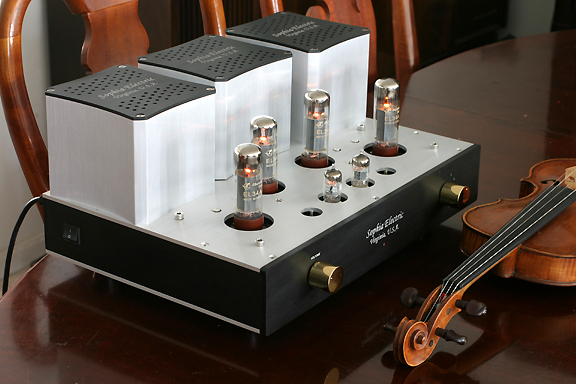|
You are reading the older HTML site
Positive Feedback ISSUE 62
The Neoteric Listener and the
Sophia Electric Magic 126S-03
Where do you go to find a hot date for your music system? Unlike what some sitcoms and late-night comics would have you believe, the Yiddish word for matchmaker is not Yenta. The correct term is Shadchen ("A Yenta is just a talkative, gossipy woman," according to sillymusic.com's Yiddish dictionary). This slightly misogynistic distinction matters when making an audio purchase. Everywhere you look, there's an expert, and there are far more gossips than gurus. Sure, I get to hear a lot of gear, but I'm the sort who liked to sit in the front row in class, so I'm always ready to listen...sometimes, to a fault. A local sales rep implores me to "Stay with the same manufacturer for everything, that way you know it's engineered to be compatible." At trade shows, I'm told in sly whispers, "Don't worry too much about trying to match components, just buy quality and you'll be all right." Meanwhile, the online smart set gives cooking analogies, saying, "A creamy amp demands a piquant interconnect to give birth to a luscious system melange," or some such twaddle. Each approach works for awhile, and all three combined are better, but I suppose the real question is whether or not you're searching for audio enjoyment or audio perfection. It's the old "journey or destination" conundrum. A high quality suite of components from, say, Bel Canto, E.A.R. or Meridian should be enough, if we'd only sit still and listen for awhile. But as Josh said in BIG, "Well, what's fun about that?" Truth be told, even if we had stereo Shamans to help us click, pay, and play, most of us would still be looking for a music gear Match.com to find the next hot system hook up. Whether this time could be better spent listening to music, perfecting a drop stitch, or rereading Less Than Zero (probably not), who's to say? But one thing I can say for sure, my Nola Contender loudspeakers sound different when driven by tube amps than they do when driven by solid state. What's more, they don't sound the same paired with various excellent quality tube amps. Complicating things even further, the Nolas, despite their claimed 8-oHm and 90 dB sensitivity, prefer 30 watt or greater amps. This truth eliminates the entire single ended triode pint-sized warrior clan, which is a pity because I really love the look and sound of those low watt 300B tube designs. That lush, warm sound definitely appeals to me, but the Nolas make the flea watt route a non-starter. Fortunately, a work around to this dilemma emerged with he opportunity to audition the Sophia Electric Magic 126S-03 integrated amplifier.
If you haven't yet read Jeff Day's excellent review of the Sophia Electric Model 91-01 300B mono amplifier, don't let it pass you by, it's really informative (you can read it in its entirety here: https://positive-feedback.com/Issue53/sophia300b.htm). The MonkeyNotes summary of his research goes like this: Dr. DWU has spent years studying the design of vintage Western Electric amplifiers, carefully notating how each engineering choice affects the sonic traits of the various models. Dr. DWU's son, Richard Wugang (now President of Sophia Electric) helped realize his father's dream by building an audio company capable of producing modern, reasonably priced amplifiers. These products still meet audiophile demands for dynamics, extended frequency range and reliability, but retain the midrange glory of highly prized Western Electric models. To that end, the The Magic 126S-03 is described by the manufacturer as a "Self-biased EL134 push-pull circuit with Pentode tubes as input/driver," that shares its sonic genesis with early Western Electric amp designs but utilizes totally modern circuit engineering. Sophia Electric claims that the output transformer design is the key to the Magic 126S-03 sounding very much like the Western Electric 124 amp, yet still having the power to drive less efficient speakers (power output of 25W per channel x 2 with input sensitivity of 0.3754V RMS). As an additional sweetener, the Magic 126S-03 incorporates a self-biasing mechanism, whereby other EL34 output tubes can be swapped out without the chore of re-biasing––great for tube rollers with limited patience. Viewing the Magic 126S-03 head on, one sees three beefy rectangular transformers standing shoulder to shoulder in the background; imposing gray guardians overlooking the quartet of output tubes arranged in a semi-circle, itself cradling a brace of input tubes. There are five RCA inputs available, which is plenty for my purposes. Don't look for the computer music, home theater, or custom install bric-a-brac on the back panel because they didn't need them back in the days when Western Electric churned out amplifiers and giant loudspeakers for telephones, and many feel they still don't. The RCA inputs worked fine with the CEntrance DACmini and Audioengine D2 DAC for computer audio via my MacBook Pro, and the rest of the time, I used an Arcam CD82 compact disc player. The stark black fascia, with its two silver knobs and glowing red power light, adorn the front of the wide shelf in a simple, yet functional arrangement that draws the eye to the display of glowing tubes that is undoubtedly the showpiece of the aesthetic design. Carefully boxed to ensure that amp and tubes arrive intact and unharmed, the entire package seems heavier than the fifty pound weight of the amp, so only those accustomed to throwing some barbells around should try to handle the unboxing and setup duties without a helping hand or two. Right from the start, getting things rolling was a piece of cake, as tubes are clearly marked and a handy card details just where they need to go. My listening room is small, so the Tannoy Eyris Ones, Nola Contender loudspeakers, and Davone Mojos fit in nicely. After about 100 hours break in time, I was ready to see if this amp is truly wondrous or just sleight of hand. In a welcome break from the flailing high school poetry that one finds on other websites, Sophia Electric describes exactly how the Magic 126S is supposed to sound: The design starts by achieving a "similar sound to the WE 124 and WE 142" that ultimately offers a "lush, buttery smooth sound, yet vivid, detail at the same time like 300B amplifier." In an email, the manufacturer adds, "The most outstanding sonic strength of this Sophia Electric 126S-03 amplifier is easy flow musicality and vintage sonic flavor. If you need power, there are plenty of available amplifiers in the market, but if you need both power and sonic refinement, then the choices are not many." Pretty strong claim, and unfortunately, there aren't a lot of Western Electric amps lying around the old homestead (nor is there the twenty grand or so it'd take to buy them should two become available) so I can't verify how close the Magic 126S comes to its illustrious forebears. What I do have, however, is a fair amount of experience listening to the Nola Contenders paired with various tube amps, including other well known amplifier models employing EL34 tubes, and the Sophia Electric amplifier definitely piques my interest. I'd thought I'd start with the Tannoy Eyris standmounts just to let the Sophia Electric take a few whiffle ball cuts at relatively small, easy to drive speakers. Early on, things were more open and vivid than I'd imagined, and it took most of the break in period for the buttery sound to churn, but by the end of the month, there was the lush sound I'd been promised. The Eyris Ones can sound a little rough with the wrong amp, but the Magic 126S-03 couldn't get grainy if you kicked sand on its beach towel. This Sophia Electric model is decidedly, unmistakably, and devoutly a tube amp's tube amp. The journey may not travel as far on the frequency highway as some amps do, but, man, what a ride! Some tube amps try to rev the solid state power throttle with one hand while the other hand takes swigs from goodbuzz tube flask. Not the Magic 126S-03, it's all about midrange excellence, wide soundstage, and fullness of tone, and it couldn't care less about power lifting with the transistor muscle shirts. I played one of my favorite cuts, Blind Willie Johnson's harrowing slide guitar masterpiece "Dark Was the Night (Cold Was the Ground)." Listening at a fairly loud volume, slide riffs, droning melody counterpoint, and Johnson's ancient lament poured through the Nolas just as sweet as blues can be when the singer ain't got nothing else but to sing. While not exactly from the same holler, but still very nice, the Derek Trucks Band (featuring Susan Tedeschi)'s rendition of "Baby, You're Right" proves that the Magic 126S can serve up ironworker solid bass lines, overdriven slide guitar, and Menthol 100s and Tanqueray blues vocals at small club levels. This amp rocks with my brand of loud--rich and powerful, but not abrasively so. The Sophia Electric may not be a monster truck, but when it growls out Ronnie Woods's Gibson Firebird on the Faces's "Stay With Me," it really rollicks the bollocks. Woody's wicked opening bass line to "Three Button Hand Me Down" from the same Faces album didn't rattle the screws of the Nolas like the Ayon might have done (or even the iNova), but it moves the feet, and that's what matters to me. Spinning Junior Senior's ubiquitous dreckno hit, "D-D-Don't Don't Stop the Beat" makes me appreciate an amp that makes the rhythm pulse, and not pound. Bottom end grip and massive headroom are not what you'll find here, but in terms of decibel personal bests; well, I got the Nolas going pretty dang loud, and this is coming from someone who played in bands with musicians who spent all day working with power tools, and then used that level as the starting point for gigs. Just for kicks, I decided to pair the Magic 126S with the 4 Ohm, 86 dB sensitivity Davone Mojos (review pending). I'd already been cautioned that these speakers needed gobs of power to take off their warm up suits, but I needn't have worried. "When Sunny Gets Blue," as played by the late be-bop guitar maestro, Sean Levitt, is the sort of airy jazz standard that gets 'em misty eyed at the trade shows, and for which the Magic 126S was created. The interplay of piano, Stella Levitt's vocals (not quite as sublime as her son's playing, unfortunately), and Sean's guitar runs sounded absolutely solid, warm, and captivating. Clearly, this spectrum is where the Magic makes its money, and those who live in the world of midrange glory, surprising muscle, and tonal richness ought to be mesmerized by the Sophia Electric Magic 126S-03. If that's you, then this amp is easy to recommend. For those who like amps that knock your hat off by moving air, you should check this amp out, too, because you might find that you prefer a wall of sound to a wall of noise. I'd say Sophia Electric has accomplished what they set out to do by producing a very sweet sounding integrated amplifier with enough power to drive any number of high quality speakers. Clearly, this is an amp that will make a lot of music systems live happily ever after.
Sophia Electric Magic 126S-03 Integrated Amp
|


